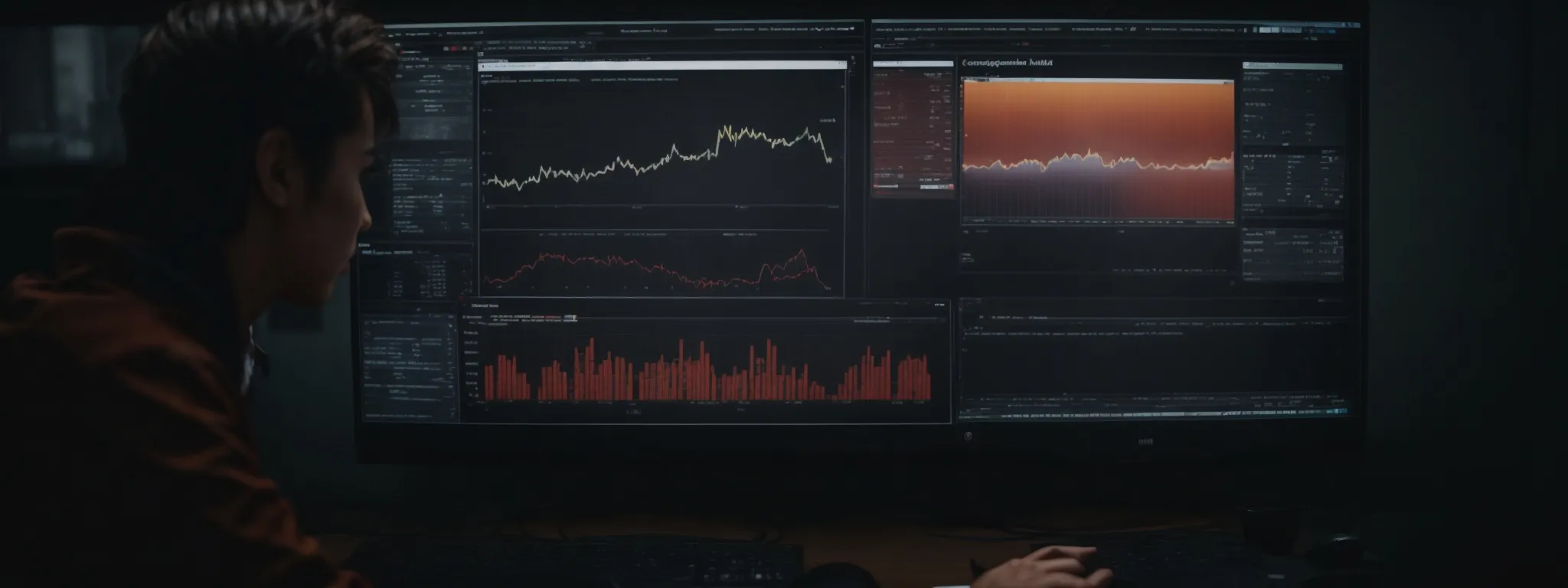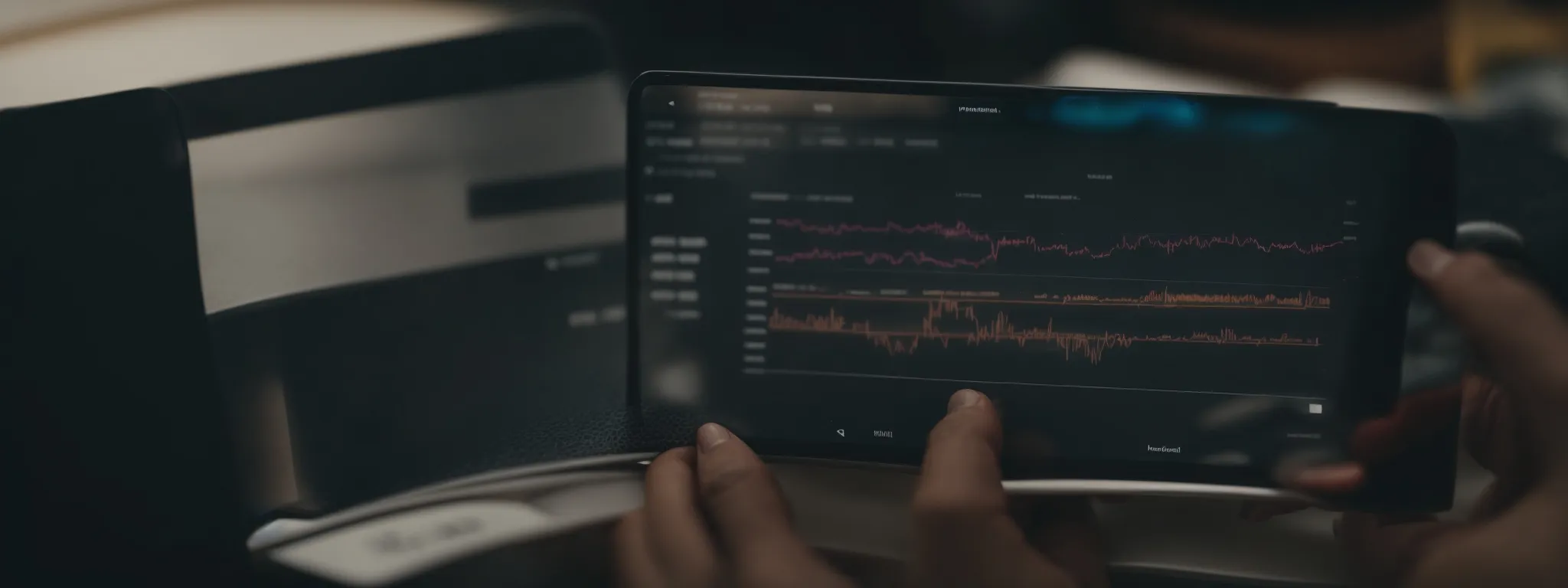Navigate Success with a Technical SEO Audit
Mastering Website Performance: How to Conduct a Technical SEO Audit In the realm of digital marketing, a well-executed technical SEO audit serves as the cornerstone for enhancing […]
Mastering Website Performance: How to Conduct a Technical SEO Audit
In the realm of digital marketing, a well-executed technical SEO audit serves as the cornerstone for enhancing a site’s search engine visibility.
As complex as the architecture of a web page may be, identifying the strengths and concerns through a meticulous review can pave the way for substantial improvements in search rankings.
Examining a website’s performance holistically, from speed metrics to mobile responsiveness, ensures that one’s digital presence is not just existing but excelling in the current competitive landscape.
Keep reading to uncover a structured approach to technical SEO audits that can transform an underperforming website into a search-optimized powerhouse.
Key Takeaways
- LinkGraph Employs a Strategic and Thorough SEO Auditing Approach to Uncover and Resolve Complex Website Issues
- Effective Use and Optimization of Technical Elements Like Meta Tags, Structured Data, and Mobile Responsiveness Are Vital for SEO Success
- Harnessing Advanced Tools Like PageSpeed Insights Enhances Site Performance and Loading Times Across Devices
- Continuous Monitoring of User Engagement Metrics Informs Ongoing Improvements for User Experience and Search Ranking
- Advanced Diagnostics in Technical SEO Audits, Such as Server Log Analysis, Improve Search Engine Indexing Efficiency
Begin With an SEO Performance Baseline Assessment

Paving the path to elevated search engine visibility commences with a thorough technical SEO audit, a critical step for understanding the intricacies of a website’s current standing.
Recognizing the importance of establishing a robust foundation, professionals at LinkGraph begin by identifying the website’s existing rank and scrutinize the flow of organic traffic as benchmarks.
This sets the groundwork for a meticulous analysis of the site’s structure, offering preliminary insights that inform the audits’ direction.
With precise goals in place, LinkGraph’s Comprehensive Audit seeks to uncover every nuance affecting site performance, ensuring that subsequent optimizations are truly impactful.
By providing clients with a clear starting point and tailored objectives, LinkGraph’s SEO services chart out a strategic course towards measurable improvements in search engine rankings.
Identify Current Site Ranking and Traffic Benchmarks
A Critical Component of an SEO Audit involves the accurate identification of a website’s search rankings and user engagement metrics. LinkGraph expertly assesses these areas, establishing performance benchmarks pivotal in mapping out an efficient SEO strategy.
Understanding how web pages are positioned on search engine results pages (SERPs) and how visitors interact with the site, LinkGraph’s consultants utilize advanced SEO tools to gather essential data. This establishes a factual baseline from which to progress:
| SEO Metric | Importance | Tools Used |
|---|---|---|
| Organic Search Ranking | Quantifies visibility on SERPs | SearchAtlas SEO software |
| Traffic Volume | Measures user engagement and reach | Google Analytics |
| Bounce Rate | Indicates user experience quality | SearchAtlas SEO software |
| Conversion Rate | Assesses effectiveness in achieving site goals | SEO reporting insights |
Analyze Website Structure for Initial Insights
Employing a methodical approach, LinkGraph Meticulously Scrutinizes a website’s architecture to identify factors that influence crawlability and indexation by search engines. The team places significant emphasis on uncovering any obstacles within the site structure that may impede search engine bots, with a keen attention to internal linking patterns, URL structures, and the proper implementation of xml sitemaps.
LinkGraph’s seasoned experts understand that a website’s architecture can either propel it to the forefront or cause it to languish in the obscurity of later search pages. They engage in a deep-seated evaluation of site architecture to ensure that each web page aligns harmoniously with the overarching SEO strategy, designed to enhance visibility and user experience.
Establish Goals for the Technical SEO Audit
Before the initiation of a detailed evaluation, LinkGraph collaborates with clients to define explicit objectives for the technical SEO audit. Targets such as enhancing site speed, rectifying crawl errors, or optimizing meta tags provide a clear focus for the in-depth examination to come.
The consultation process enables LinkGraph’s specialists to customize the audit’s scope to match the client’s unique requirements, setting attainable milestones for improving search rankings and user experience. A strategic plan thus emerges, poised to systematically elevate the client’s digital presence through precision-driven audit goals.
Deploy Crawling Tools to Identify Technical Issues

Success in SEO rests on the pillars of proactive detection and resolution of technical issues that can undermine a site’s search engine ranking.
To that end, deploying sophisticated crawling tools is a vital step in the technical SEO audit process.
It’s here where LinkGraph employs the likes of Screaming Frog to orchestrate a deep dive into the website’s nooks and crannies.
From pinpointing crawl errors that frustrate search engines to evaluating the labyrinth of internal links, these tools are the forensic experts in a digital investigation, uncovering the hidden elements that influence a website’s performance in search results.
Set Up and Run Website Crawlers Like Screaming Frog
Embarking on a technical SEO audit, the deployment of an adept crawling tool like Screaming Frog is indispensable for LinkGraph’s experts to canvas a website’s complex ecosystem. These robust crawler tools facilitate a thorough examination of the site, indexing each page much like a search engine would, to expose a myriad of technical issues that may be lurking below the surface.
| Technical Element | Purpose of Analysis | Outcome |
|---|---|---|
| Response Codes | Detects page errors and redirects | Identification of broken links and server issues |
| Page Titles & Meta Descriptions | Evaluates relevance and SEO optimization | Optimization for improved SERP performance |
| Content Quality | Assesses duplication and keyword usage | Enhanced content strategy for higher ranking |
| URL Structure | Ensures consistency and search friendliness | Streamlined navigation and better indexing |
With Screaming Frog Meticulously Initiated, LinkGraph’s consultants proceed to configure and fine-tune the tool, orchestrating a series of scans that sweep through the website’s digital terrain. This strategic approach ensures every critical element, from load times to metadata consistency, is assessed, setting the stage for insightful SEO enhancements.
Track Down Crawl Errors and Broken Links
Uncovering crawl errors and rectifying broken links are focal points for LinkGraph’s meticulous audit process. Finding these issues is essential as they can significantly impede a website’s ability to rank well by disrupting the experience for both users and search engine crawlers.
Upon detection, the LinkGraph team embarks on a meticulous journey of correction, ensuring that web page connectivity is restored and optimized for seamless navigation. Such attention to detail underscores the value of a thorough SEO audit: restoring the integrity of a site’s framework:
- Diagnose and repair broken links to bolster user experience and crawl efficiency.
- Resolve crawl errors to enhance search engine visibility and website health.
- Optimize URL redirections to maintain link equity and prevent visitor frustration.
With adept identification and swift resolution of technical issues, LinkGraph Ensures that the foundational elements of the client’s website are robust, thus fostering an environment conducive to superior search rankings and user satisfaction.
Evaluate Website Crawl Depth and Internal Linking
Delving into the intricacies of crawl depth, LinkGraph’s Tools Analyze how many clicks away pages are from the homepage, gauging their accessibility to search engine bots. Prioritizing the interconnectivity of a site, the firm ensures deep-seated content surfaces effectively in Search Engine Results Pages (SERPs), making critical content reachable through a strategically woven web of internal links.
Through meticulous evaluation, LinkGraph optimizes the internal linking structure to ensure equitable distribution of page authority throughout the site. This not only assists in establishing a clear hierarchy but also augments the thematic relevance across various pages, amplifying the potential for higher domain authority and better user navigation.
Assess Website Loading Speed and Performance

In the dynamic realm of Search Engine Optimization, speed is a fundamental metric that significantly impacts a website’s user experience and, by extension, its SERP ranking.
Site performance is thus a critical aspect of a technical SEO audit.
By utilizing tools such as PageSpeed Insights, LinkGraph’s team conducts extensive diagnostics to pinpoint and alleviate elements that lead to slow page loading.
Beyond mere identification, the team recommends and facilitates changes like deploying Accelerated Mobile Pages (AMP) to ensure optimal performance across devices, particularly mobile where user patience is particularly fleeting.
Altogether, these efforts are aimed at crafting an online presence that not only attracts but retains visitor engagement, providing a swift and seamless experience.
Utilize PageSpeed Insights for Speed Diagnostics
In today’s digital sphere, the speed at which a page loads can make or break a website’s ability to retain its visitors. Recognizing this, LinkGraph harnesses the analytical prowess of PageSpeed Insights to conduct rigorous performance diagnostics, seeking to enhance every facet of a site’s loading speed.
This tool grants LinkGraph’s team a detailed view of performance bottlenecks, enabling them to recommend strategic interventions tailored to each unique aspect of the client’s web presence:
- Identification and minimization of render-blocking resources that delay page display.
- Optimization of images and file compression to quicken load times without compromising quality.
- Implementation of browser caching policies that facilitate quicker loading on repeat visits.
LinkGraph’s expertise ensures that these insights translate into actionable solutions, ultimately sculpting an expedited browsing experience that aligns with both user expectations and search engine preferences.
Identify and Rectify Slow-Loading Resources
In an era where online experiences are expected to be instantaneous, LinkGraph’s expertise in diagnosing slow-loading website resources is second to none. With meticulous precision, the team pinpoints elements that contribute to latency issues, from cumbersome scripts to oversized multimedia files, and implements strategic optimizations that significantly reduce loading times.
Operating with an unwavering commitment to enhance site performance, LinkGraph’s professionals adeptly reconfigure resource delivery mechanisms, ensuring swift and efficient content rendering. The result is a pronounced uplift in page speed, directly correlating to an improved user experience and a stronger position in the competitive landscape of search engine rankings.
Consider Implementing AMP for Mobile Optimization
In the pursuit of seamless mobile experiences, LinkGraph recognizes the pivotal role of Accelerated Mobile Pages (AMP) in improving website performance. The Implementation of AMP ensures near-instantaneous loading times on mobile devices, a factor that can significantly enhance user engagement and contribute to higher search engine ranking.
LinkGraph’s Forward-Thinking Strategy includes the adaptation of AMP not merely as a feature but as a competitive necessity. This advanced approach aligns with contemporary mobile usage trends, placing clients at the forefront of mobile optimization through a proactive embrace of cutting-edge technology.
Conduct a Mobile-Friendliness Evaluation

In an era where the majority of users access the internet via mobile devices, evaluating a website’s mobile-friendliness is a paramount facet of any technical SEO audit.
A comprehensive examination of a site’s responsiveness and mobile usability stands as a cornerstone of LinkGraph’s meticulous approach.
Their seasoned experts adeptly navigate the nuances of mobile optimization—ranging from conducting tests using Google’s established mobile-friendly diagnostics, identifying and resolving design impediments, to refining the touch element’s functionality and viewport parameters.
These measures coalesce to fortify a website’s appeal and functionality across the spectrum of mobile devices, cementing its place within the mobile-centric world of modern-day search engine rankings.
Run Google’s Mobile-Friendly Test
Embarking on mobile optimization, LinkGraph incorporates Google’s Mobile-Friendly Test, an essential tool that evaluates a website’s compatibility with mobile devices. This test scrutinizes a website to ensure it adapts and functions seamlessly across the diverse range of mobile screens and user interfaces.
LinkGraph’s adept use of this diagnostic tool provides clients with a concise understanding of how their website performs on mobile devices, pinpointing specific areas that require enhancement:
| Aspect Evaluated | Mobile-Friendly Criteria | Impact on User Experience |
|---|---|---|
| Text Readability | Font size and scaling | Ensures legibility on small screens |
| Content Width | Viewport settings and scrolling | Eliminates horizontal scrolling |
| Link Spacing | Adequate separation of touch elements | Facilitates easier navigation |
| Responsive Design | Dynamic content sizing and fluid grids | Delivers a consistent experience across devices |
Check Responsive Design and Mobile Usability Issues
LinkGraph Scrutinizes the Responsiveness of a website as an integral element of mobile-friendliness. Their assessment concentrates on design fluidity across various devices, ensuring content renders effectively without loss of functionality or aesthetics.
During these evaluations, usability concerns such as navigation ease and interactive element accessibility are thoroughly examined. LinkGraph’s commitment to optimizing responsive design plays a critical role in delivering a superior mobile experience catered to user behaviors and preferences.
Improve Touch Elements and Mobile Viewport Settings
In the realm of mobile optimization, the refinement of Touch Elements and Viewport Settings is a pivotal consideration. LinkGraph recognizes that intuitive touch interfaces and properly configured viewports contribute significantly to a seamless mobile user experience. Therefore, the firm meticulously enhances touch responsiveness and optimizes viewport configurations to meet the stringent requirements of today’s mobile-centric online environment.
By honing the precision of touch elements, LinkGraph ensures that actions such as tapping, swiping, and pinching are fluid and error-free for the user. Moreover, adjusting mobile viewport settings to adapt dynamically to device-specific resolutions plays a vital role in maintaining the visual and operational integrity of a website across all mobile platforms:
| Mobile Element | Action | Result |
|---|---|---|
| Touch Responsiveness | Optimize touch targets and feedback | Enhanced navigational precision |
| Viewport Configuration | Implement dynamic scaling | Uniform display across devices |
Dive Deep Into Indexation Analysis

Scrutinizing indexation is imperative for gaining a comprehensive understanding of how search engines perceive and assimilate a website’s content.
A technical SEO audit remains incomplete without a detailed analysis of indexation status, a process that LinkGraph navigates with expert precision.
The firm’s focus on evaluating Google Search Console data, reconciling sitemap URLs with the pages search engines have indexed, and identifying potential redundancies paves the way for enhanced content clarity.
By addressing index bloat and content duplication, LinkGraph crafts a streamlined path for search engines to index the website efficiently, bolstering its visibility and ranking potential.
Review Google Search Console Indexation Status
LinkGraph’s strategic analysis invariably encompasses the insights provided by Google Search Console to ascertain a website’s indexation status. This empowers the firm’s experts to detect disparities in the indexation of web pages as intended versus what the search engines actually reflect, fostering opportunities to enhance search visibility.
The meticulous review process by LinkGraph enables the identification and resolution of indexation issues with agility. Rectifying discrepancies in the indexation process is instrumental for clients aiming to secure their content’s rightful place within the labyrinthine databases of search engines, thus optimizing the online footprint.
Cross-Check Sitemap URLs With Indexed Pages
In the meticulous process of technical SEO auditing, LinkGraph conducts a thorough cross-check between sitemap URLs and the pages index engines have cataloged. Ensuring concordance between these two critical lists is essential for optimizing the indexation process, a step that significantly affects a website’s visibility and ranking prowess.
LinkGraph’s experts scrutinize the sitemap fidelity, confirming that each URL intended for search engine consumption is appropriately accounted for within the index. Disparities or omissions are systematically addressed, fortifying the site’s structure and amplifying its footprint in the digital landscape mapped by search engines.
Detect and Resolve Index Bloat or Content Duplication
Amidst the intricate labyrinth of indexation lies the often-overlooked challenge of index bloat and duplicate content, phenomena that dilute a website’s SEO efficacy. LinkGraph’s adroit analysis is geared towards identifying superfluous pages and redundant articles, swiftly implementing remedies that distill a website’s content to its most potent and search-friendly form.
At the heart of enhancing a website’s indexation efficiency, LinkGraph’s experts meticulously uncover and consolidate duplicate pages, redirecting or removing them as necessary to refine the website’s narrative. Such precision in pruning ensures a more cohesive and authoritative online presence, pivotal for achieving prominence amidst the search engine hierarchy.
Optimize on-Site SEO Elements

Securing a commanding online presence transcends beyond the foundational elements of technical SEO, directing attention to the vital on-page attributes that determine a website’s ability to communicate effectively with search engine algorithms.
Mastery in this realm is exemplified through meticulous audits of meta tags, assurance in the strategic deployment of alt text, and the finessing of content for maximal readability through keyword optimization.
In the quest to conquer digital landscapes, LinkGraph maneuvers these on-site elements with adept precision to solidify a website’s authority and relevance in the eyes of both search engines and users.
The following elucidates the steps LinkGraph’s professionals take in optimizing these crucial SEO elements to magnify a site’s resonance with its target audience.
Audit Meta Tags, Headings, and Descriptions for SEO
At the heart of on-page Search Engine Optimization lies The Strategic Refinement of Meta Tags, headings, and descriptions. LinkGraph conducts exhaustive audits to ensure these elements are not only accurately reflecting the content’s core themes but are also configured to maximize SEO potency.
Proper utilization and optimization of these SEO elements are pivotal for enhancing a website’s clarity and discoverability:
- Meta tags are meticulously crafted to serve as precise indicators of page content for search engines.
- Headings are structured to convey the hierarchical flow and to prioritize keywords effectively.
- Descriptions are optimized to encapsulate the essence of the content while enticing potential visitors in SERPs.
LinkGraph’s expertise is manifest in the ability to seamlessly integrate target keywords within these components, bolstering relevance and fostering user engagement.
Ensure Proper Use and Structure of Alt Text on Images
In the meticulous realm of on-site SEO, the proper use and structuring of alt text on images cannot be overstated. LinkGraph ensures that each visual element within a client’s digital space features descriptive, keyword-rich alt text, thereby providing clarity for search engines and enhancing the content’s accessibility for all users, including those with visual impairments.
LinkGraph’s strategy involves a careful analysis of images to guarantee their alt attributes are not only contextually relevant but also SEO-friendly. These attributes play a critical dual role, assisting search engine crawlers in deciphering the content and context of the image while simultaneously improving the web page’s overall SEO performance.
Enhance Content Readability With Keyword Optimization
Ascendancy in search rankings correlates strongly with the readability of content and the strategic use of keywords within it. LinkGraph emphasizes the importance of optimizing content to align with user intent, ensuring both comprehensibility for the audience and relevance to search algorithms.
Key phrases strategically interspersed throughout the text bolster search engine understanding and user experience. This optimization not only elevates content in terms of SEO, but also enhances the engagement potential for contemporary readers, keeping retention rates high:
| SEO Factor | Action by LinkGraph | Outcome for Client |
|---|---|---|
| Keyword Relevance | Integrate targeted keywords seamlessly | Amplify content visibility on SERPs |
| Readability | Curate clear, accessible content | Improve user engagement and dwell time |
| Content Structure | Organize headings and subheadings for ease of navigation | Foster enhanced user experience, leading to better conversion rates |
Validate Website Security Measures

In an age dominated by concerns of digital safety and privacy, validating website security measures stands as a critical pillar within the framework of a technical SEO audit.
A safe browsing experience underpins the trust and credibility that users place in a website, which search engines like Google now factor into their ranking algorithms.
Ensuring that a website employs HTTPS encryption and that its SSL certificate is both present and valid is merely the beginning.
Experts at LinkGraph delve further, rigorously inspecting for any occurrence of mixed content and uncovering potential security gaps while also affirming alignment with stringent data protection standards.
These proactive defensive measures safeguard the integrity of both the website and its visitor data, fortifying its stature in the panoramic view of search engine evaluation.
Confirm HTTPS Encryption and SSL Certificate Validity
In the vigilant pursuit of website security, confirming HTTPS encryption emerges as a non-negotiable checkpoint in LinkGraph’s technical SEO audit. HTTPS, representative of secure data transfer, is verified to ensure the encryption of user data, augmenting the trustworthiness of a client’s digital footprint.
Alongside encryption verification, LinkGraph’s detailed security assessment incorporates the evaluation of SSL (Secure Sockets Layer) certificate validity. This measure is vital as it guarantees secure connections from a web server to a browser, thereby upholding the integrity of the website and reinforcing its credibility from an SEO perspective.
Scrutinize for Mixed Content and Security Loopholes
In a technical SEO audit, vigilance against mixed content is a priority, ensuring that all resources on a secure webpage are served over HTTPS. LinkGraph diligently identifies and rectifies any instances where unsecured elements, such as images or scripts, are requested via HTTP, eliminating security warnings that can discourage user trust and tarnish a website’s search engine standing.
Proactively seeking out security loopholes is another critical task managed by LinkGraph’s skilled professionals. They employ advanced security scanning methods to detect vulnerabilities, swiftly implementing solutions that bolster a website’s defense against potential threats–a decisive factor in sustaining both user confidence and a website’s authoritative reputation in search algorithms.
Ensure Compliance With Data Protection Regulations
LinkGraph’s dedication to thorough technical SEO audits encompasses vigilance towards compliance with data protection regulations. Their experts expertly verify adherence to GDPR, CCPA, and other privacy laws, ensuring that a website’s data handling practices meet legal standards, thereby preserving the website’s integrity and search engine trustworthiness.
By meticulously safeguarding compliance, LinkGraph positions its clients at the forefront of best practices in data protection. This comprehensive approach not only aligns with regulatory demands but also fortifies user trust, an increasingly critical component in the algorithmic calculus of search engine rankings.
Check for Proper Implementation of Technical Tags

In an age where the intricacies of SEO can dictate the trajectory of a website’s success, the meticulous evaluation of technical tags becomes a key operative in the complicated mechanism of search engine optimization.
A sophisticated technical SEO audit delves into the realm of canonical tags to safeguard against content redundancy; it hones in on schema markup to leverage the power of structured data, and assesses hreflang tags to ensure precise targeting across language and regional divides.
By encapsulating these pivotal aspects, LinkGraph skillfully navigates the delicate interplay between technical precision and the broad narrative of a brand’s digital presence, setting the stage for an SEO strategy that is both comprehensive and nuanced.
Audit Canonical Tags to Prevent Duplicate Content Issues
In the intricate landscape of technical SEO, Auditing Canonical Tags is an essential measure to mitigate duplicate content issues that potentially dilute a website’s SEO efficacy. LinkGraph seamlessly undertakes this review process, verifying that canonical tags are implemented correctly, signalling to search engines the preferred version of a page when similar or identical content exists within the site.
This level of scrutiny ensures content is attributed to the correct page, preventing the splintering of link equity among several URLs and consolidating a site’s search ranking power. With LinkGraph’s meticulous approach, clients can rest assured their website upholds the clarity and integrity required by contemporary search algorithms.
Verify Schema Markup for Structured Data Optimization
Optimizing for search engines extends into the realm of structured data, where schema markup plays a pivotal role. LinkGraph’s services include a verification process to confirm whether a website’s schema markup is correctly implemented, ensuring that search engines can effortlessly interpret the context of the content, enhancing visibility and accuracy in search results.
LinkGraph’s expertise ensures that schema markup is not merely present but is utilized effectively to enrich search snippets with information that stands out to users. This structural clarity provided by schema optimization is crucial for websites aiming to captivate and inform their audience directly from the SERPs, thereby improving click-through rates and competitive edge.
Review Hreflang Tags for Multilingual and International SEO
LinkGraph elevates the precision of technical SEO audits with a thorough review of hreflang tags for websites serving a global audience. These tags are essential for signaling to search engines which language or regional version of a site should be presented in search results, thereby fine-tuning international SEO efforts.
Ensuring hreflang tags are utilized accurately is key to providing a user-friendly experience for a multilingual audience, guiding them to the content in their preferred language. Failure to implement these tags correctly can result in a disjointed user experience and impede a website’s ability to rank in varied linguistic markets:
- Assessing hreflang tag accuracy to match users with the correct language version.
- Diagnosing potential tag conflicts that could confuse search engine algorithms.
- Implementing precise regional targeting to improve global search visibility.
Test for User Experience and Engagement Metrics

Delving into the dimensions of user experience (UX) and engagement, LinkGraph extends its technical SEO audit to encompass the qualitative aspects that encapsulate a visitor’s interaction with the website.
This examination pivots around meticulously analyzing behavioral metrics, such as bounce rate and session duration, which unfailingly reflect the resonance and relevance of a page to its audience.
LinkGraph’s methodical approach underscores the importance of clear navigation pathways and compelling call-to-action elements, while also advocating for the optimization of page layouts to captivate and retain users’ attention, fostering interactions that translate into tangible business outcomes.
Examine Bounce Rate and Page Session Duration
LinkGraph’s analytics delves into Engagement Indicators Such as Bounce Rate and session duration to gain a profound understanding of user interactions. These metrics provide invaluable insight into visitor behavior, offering a window into the efficacy of on-site content and the user’s journey through the site’s pages.
Gauging these user experience metrics arms LinkGraph’s specialists with the knowledge needed to refine web pages, ensuring they captivate and maintain the audience’s interest. Further, it aids in pinpointing areas where the user’s needs may not be fully met, guiding strategic enhancements tailored to improve overall site engagement.
Ensure Clear Navigation and Call-to-Action Elements
In the complex ecosystem of a website, clarity and intuitiveness in navigation are paramount for sustaining user engagement and guiding them to the desired actions. LinkGraph prioritizes the Optimization of Navigational Elements, ensuring that users can effortlessly traverse the website, enhancing the likelihood of fulfilling the intended actions that drive business objectives.
Strategically placed call-to-action (CTA) elements serve as catalysts for user interaction and conversion. Applying this critical focus, LinkGraph enhances these prompts within the website’s framework, refining their visibility and persuasiveness to support the conversion journey:
- Analyze navigational patterns to streamline user pathways.
- Optimize CTA placement for maximum impact and clarity.
- Test CTA verbiage and design to boost user response rates.
Optimize Page Layouts for Enhanced User Engagement
LinkGraph’s commitment to enhancing user engagement extends to The Strategic Optimization of Page Layouts. By assessing elements such as visual hierarchies, content organization, and the balance of text and graphical elements, their consultants create page designs that are not only aesthetically pleasing but also facilitate an effortless and intuitive user journey.
Understanding that user engagement is paramount, LinkGraph ensures that each page layout is evaluated and tweaked to provide a frictionless user experience. This includes ensuring the strategic placement of engaging elements and valuable content in areas of a page that are most likely to capture user attention and engagement.
Polish Your Audit With Advanced SEO Techniques

In the pursuit of digital excellence, technical SEO audit procedures must transcend foundational analyses to embrace more sophisticated methodologies.
Pioneering experts at LinkGraph integrate cutting-edge SEO techniques to further refine website performance.
Investigation into intricate JavaScript and CSS rendering issues is initiated to ensure flawless delivery of content and style.
XML sitemaps and robot directives come under exacting scrutiny to optimize crawlers’ pathways, while the strategic analysis of server log files unveils opportunities to streamline search engine crawl efficiency.
Such advanced diagnostic practices embody LinkGraph’s commitment to leaving no stone unturned in magnifying a website’s visibility and operability.
Investigate JavaScript and CSS Rendering Issues
Within the scope of a technical SEO audit, investigating JavaScript and CSS rendering issues is paramount for ensuring that a website’s dynamic content and style elements are correctly displayed across various browsers and devices. LinkGraph takes a proactive stance by meticulously examining how JavaScript code executes and how CSS is applied, looking for potential barriers that could prevent search engines from accurately rendering pages.
LinkGraph’s experienced professionals employ a suite of diagnostic tools to evaluate the website’s front-end code for discrepancies that may impact user experience and search engine indexing. This process includes analysis of deferred or asynchronous JavaScript, as well as the optimization of CSS delivery to minimize render-blocking resources:
| Rendering Challenge | Diagnostic Approach | Outcome Objectives |
|---|---|---|
| JavaScript Execution | Evaluate execution timing and event triggers | Ensure complete and accurate page rendering |
| CSS Application | Analyze style sheet linkages and media queries | Improve page load times and visual consistency |
Fine-Tune XML Sitemaps and Robot Directives
To achieve precision in guiding search engine crawlers, LinkGraph champions the fine-tuning of XML sitemaps and robot directives. A well-crafted XML sitemap acts as a blueprint of the website’s content, serving to expedite the indexing process by presenting search engines with a curated list of URLs deemed critical for discovery.
Simultaneously, the strategic management of robot directives, via robots.txt files and meta tags, empowers LinkGraph to signal crawlers on the pathways to follow, preventing redundant resource allocation to trivial or duplicate pages. Expert manipulation of these directives steers search engine bots with optimized efficiency, ensuring prime content prioritization:
| Sitemap Attribute | Function | Optimization Goal |
|---|---|---|
| XML Sitemap URLs | Direct crawlers to essential pages | Streamline indexation for enhanced visibility |
| Robot Directives | Guide crawler access and indexation behavior | Target optimal resource utilization for search crawls |
Leverage Server Log Files to Refine Crawl Efficiency
The definitive analysis of server log files stands as a testament to LinkGraph’s commitment to SEO mastery. In filtering through this data, LinkGraph’s SEO connoisseurs extrapolate patterns and frequencies of search engine crawls, employing this knowledge to fine-tune a website’s accessibility to these digital explorers.
By leveraging server log file insights, LinkGraph executes Strategic Modifications that optimally allocate crawl budget, ensuring that search engines efficiently index the site’s most valuable pages. This subtle yet powerful manipulation of crawler behavior directly influences a website’s search engine presence and performance.
Conclusion
Conducting a technical SEO audit is fundamental for any website seeking to master its online performance and improve search engine rankings.
Starting with a thorough baseline assessment, LinkGraph establishes a clear understanding of a site’s current rankings and organic traffic flow.
By examining site structure and establishing specific audit goals, LinkGraph sets the stage for a strategic enhancement plan.
Crawling tools such as Screaming Frog allow for the identification of various technical issues that can impact a website’s search visibility.
Load times and performance are scrutinized using tools like PageSpeed Insights, ensuring that slow-loading resources are optimized and, if necessary, implementing Accelerated Mobile Pages (AMP) to improve mobile experience.
A website’s mobile-friendliness is also evaluated rigorously to ensure a seamless cross-device user experience.
Indexation analysis, including reviewing Google Search Console data and verifying sitemap accuracy, unfolds opportunities to streamline content visibility.
Further, on-site SEO elements—meta tags, alt text, and content readability—are all audited to enhance relevance and engagement.
Security validations, such as confirming HTTPS encryption and scrutinizing for potential security loopholes, form another critical component of the audit.
Compliance with data protection regulations is ensured to maintain trust and adherence to legal standards.
Advanced SEO approaches delve deeper, examining the nuances of technical tags—such as canonical tags, schema markup, and hreflang tags—to ensure content clarity and appropriate targeting.
An exploration into JavaScript/CSS rendering issues, sitemaps, robot directives, and server log files is conducted to refine the website’s ability to perform seamlessly for both users and search engine bots.
Lastly, user experience metrics like bounce rate and session durations are assessed to guide further enhancements in navigation, call-to-action elements, and page layouts, creating engaging user journeys.
In conclusion, mastering website performance through a comprehensive technical SEO audit is a powerful way to optimize a site’s search engine placement, user experience, and overall business success.
LinkGraph’s rigorous process identifies key areas for improvement, paving the way for strategies that ensure a website reaches its full digital potential.














































































